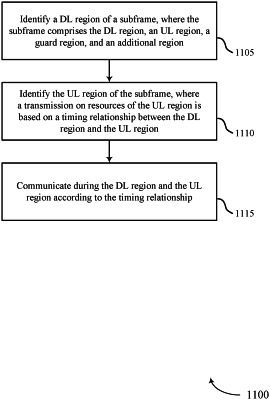| CPC H04L 5/14 (2013.01) [H04L 1/1812 (2013.01); H04L 5/1469 (2013.01); H04W 72/20 (2023.01); H04W 76/27 (2018.02); H04L 5/0092 (2013.01); H04W 88/02 (2013.01)] | 30 Claims |

|
1. A method of wireless communication comprising:
identifying a downlink (DL) region of a subframe, wherein the subframe comprises the DL region, an uplink (UL) region, a guard region, and an additional region;
identifying the UL region of the subframe, wherein a transmission on resources of the UL region is based at least in part on a timing relationship between the DL region and the UL region; and
communicating during the DL region and the UL region according to the timing relationship, wherein the timing relationship between the DL region and the UL region comprises a specified minimum time duration for performing same-subframe scheduling of hybrid automatic repeat request (HARQ) feedback for subframes having separate regions for UL and DL communications and is based at least in part on a serving cell that schedules communications during the subframe, and wherein a first duration of the DL region or a second duration of the UL region are based at least in part on the specified minimum time duration.
|